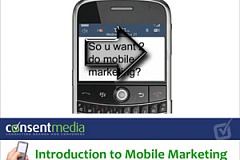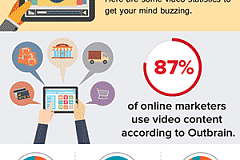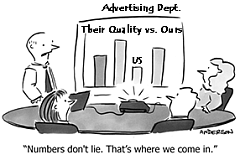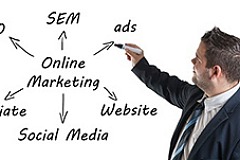 If you're in business to supply products or services to other companies, then account-based marketing holds several possible benefits for you.
If you're in business to supply products or services to other companies, then account-based marketing holds several possible benefits for you.
Finding the right customers is among the core agendas of businesses that want to succeed. Yet, according to Hub Spot, most small businesses struggle to get a consistent client base.
The trick to successful marketing isn't getting many eyeballs on your product or services but on those who can purchase. This is what account-based marketing does.
So, if you're in business to supply products and services to other companies (B2B), account-based marketing has several benefits. Here's how ABM works and how you can apply it in your business regardless of the size of your company.
The Big Advantage of Account-Based Marketing
Most businesses employ two kinds of marketing – mass marketing through TV and radio or targeted marketing via social media. While these techniques work, they may take longer before you see any significant results, and therefore they are not suitable for growing businesses.
Account-based marketing is like casting your net into a narrower pool to increase your chances of landing an ideal client. Simply put, ABM is a marketing tactic employed by your sales and marketing team that involves targeting specific business accounts to become clients.
Types of Account-Based Marketing
[quotes]Account-based marketing can take different forms for different companies.[/quotes] The marketing style you choose depends on your company size and its short-term and long-term goals. These include Strategic ABM, ABM lite, and Programmatic ABM.
Strategic ABM is a one-on-one marketing method employed by a business looking to secure a few but profitable clients. Companies that use strategic ABM usually work with select accounts to ensure they get a complete service.
Here, a senior marketer manages a single account with a small team of experts to craft customized marketing programs for each account. The aim for one-on-one ABM is for businesses to establish strong ties with their valued customers.
ABM Lite. Also known as the one-to-few model, ABM Lite is slightly similar to Strategic ABM but involves managing small clusters of accounts instead of individual ones. Since most companies share the same challenges and opportunities, it is easier to manage them as a unit.
So, most marketing strategies apply to all the companies in a cluster except for a few items that you customize for each. A cluster could have as many as five to 10 individual accounts that work together to increase their revenue and eventually join strategic ABM.
Programmatic ABM is the recent innovation in account-based marketing that's revolutionizing marketing as a whole. Referred to as the one-to-many model, this strategy involves using IP advertising and physical mail tools to target hundreds if not thousands of specific accounts.
While this type of ABM may seem similar to mass marketing, it employs different strategies to balance scale and customization. This way, it remains just as effective as ABM lite and strategic ABM.
How to Apply ABM and Grow your Business
The thought of moving from traditional methods of advertising can sound scary. But, when the sales and marketing departments combine heads, a lot can be achieved. Below we outline what you and your team should do to ensure success.
Identify your Ideal Set of Target Accounts
This involves using all tools at your disposal to locate accounts that fit in your long-term strategy and have room for growth. If your ideal customer is already among your client base, use them as a benchmark to locate similar accounts.
Of course, they need to be high-value accounts that can give a good ROI for the workforce and time used. The best criteria for identifying valuable accounts include:
- Search on LinkedIn for your ideal customer profile,
- Create a system that eliminates companies based on size, or industry,
- Use lighthouse accounts as a reference, and
- Pick target accounts based on geographic location.
Growing businesses with a valuation of $2 million or below should avoid aiming for too high clients as they may not deliver.
Map Out the Decision Makers of Accounts
In every organization, some individuals influence the final buying decision. These are the people you want to target since once they're on board with your plan, they can also persuade others to get on board.
They include company CMO's, CIO's digital marketing officers, and even CFO's. If it's a team rather than an individual, assign competent members of your team to reach out to each of them and try to establish connections.
The goal is to get them to make a unanimous decision to become customers. Thus, everyone on your team must be on the same page strategy-wise.
Determine the Communication Process
[quotes]Since most communication happens online and not face to face, the message and communication channels must align.[/quotes] Remember, good communication sets a solid base for future business.
Tailor your message to address individual business concerns and how you can solve them. In short, don't make it about you, but rather about them and their challenges. After initial contacts, use the channels they leverage most to communicate this message. These could be through web, email, or mobile, depending on the account you're targeting.
Create and Execute a Targeted Campaign
A targeted campaign is perhaps the most crucial part of account-based marketing because the campaign must be relevant to the account. [quotesright]The secret to successful campaigns is using email marketing, automation, and CRM tools throughout the campaign. [/quotesright]
These tools can coordinate your marketing campaigns across all channels and ensure the marketing and sales team is on the same page. Further, you can create campaigns for the individual accounts you'll be targeting by designing them around each company’s mission, vision, and culture.
Tip: Make your campaigns story-based since great stories back up your points and tap into people's emotions.
Measure and Optimize
In the end, the success or failure of your campaign will be determined by the results – how many accounts are added. So, use automation tools to track your metrics and see how your campaigns are performing.
On the off chance that they're not working, identify the main problems and try to come up with solutions even if it means tweaking your campaigns. [quotesright]Measuring and optimizing is the only way to ensure your campaigns keep improving for maximum impact. [/quotesright]
Benefits of Account-Based Marketing
All types of businesses can benefit from ABM, whether big or small. Given that you manage the change to account-based marketing strategies correctly, here are some of the benefits you stand to enjoy:
Clear Return on Investment. At the end of a campaign, you should measure whether the campaign was a success or not by looking at the ROI. ABM allows you to measure the ROI of each account, depending on the time and resources put into it.
This way, you can determine if your ABM tactics are working or not. If they are and you've been landing high-value accounts, apply them in subsequent campaigns to land more suitable clients.
Affordability. [quotes]Compared to traditional marketing methods, ABM is far more affordable.[/quotes] This is because the model focuses on maximizing sales from specific high values rather than the entire market.
Furthermore, ABM doesn't need a big marketing team to execute. Since the focus is on creating long-term relationships with clients, only a few personnel are required to manage individual accounts.
Personalization. ABM is all about forging relationships with individual accounts for long-term success. Here, the marketing team collects as much data about accounts before targeting them with their campaigns to create personalized experiences.
Once accounts develop a loyalty to your products and services from the bond, they become long-term clients. Plus, they'll happily refer your business to other high-value accounts.
More Controlled Marketing. Account-based marketing is more controllable than large-scale campaigns that are usually out of your hands. For example, you have no control over how many people click your ad on a website.
But, with ABM, you handle a few accounts at a time, which gives you better control over the marketing process.
Companies that Successfully Leverage ABM
There are numerous success stories of companies using ABM to catapult their marketing and meet their bottom line. These three are among the most popular.
Genesys. This company uses LinkedIn as its platform of choice for its ABM program. From there, using LinkedIn sponsored content and account targeting capabilities, their team runs several ABM campaigns. [quotesright]As a result, their ABM campaigns capture 60 percent of all net new leads. [/quotesright]
Service Now. Service Now is one of the companies that benefits from LinkedIn targeting capabilities. The company delivers content to key stakeholders of privileged accounts and has registered a 100 percent improvement in form fills.
Spigit. Using LinkedIn-sponsored content and targeting capabilities, Spigit runs several campaigns that yield maximum results. According to Lin Ling, a growth marketer, they've realized a CTR high of 0.517 percent and an engagement of 0.567 percent, all above their initial expectations.
Grow Faster Through Account-Based Marketing
There is no doubt that account-based marketing is the present and future of marketing. Provided you apply ABM strategies correctly, the model is bound to give you results. Furthermore, you'll have control over every step in the process.
Want to explore further? Questions?
Does ABM sound like it has potential for your company? Let us show you how to increase profit margins by implementing it and capitalizing on the leads ABM produces. We know, we use ABM ourselves!
Get in touch and let's set up a time to talk. Brian Tracy USA: 877.433.6225 Email Me














